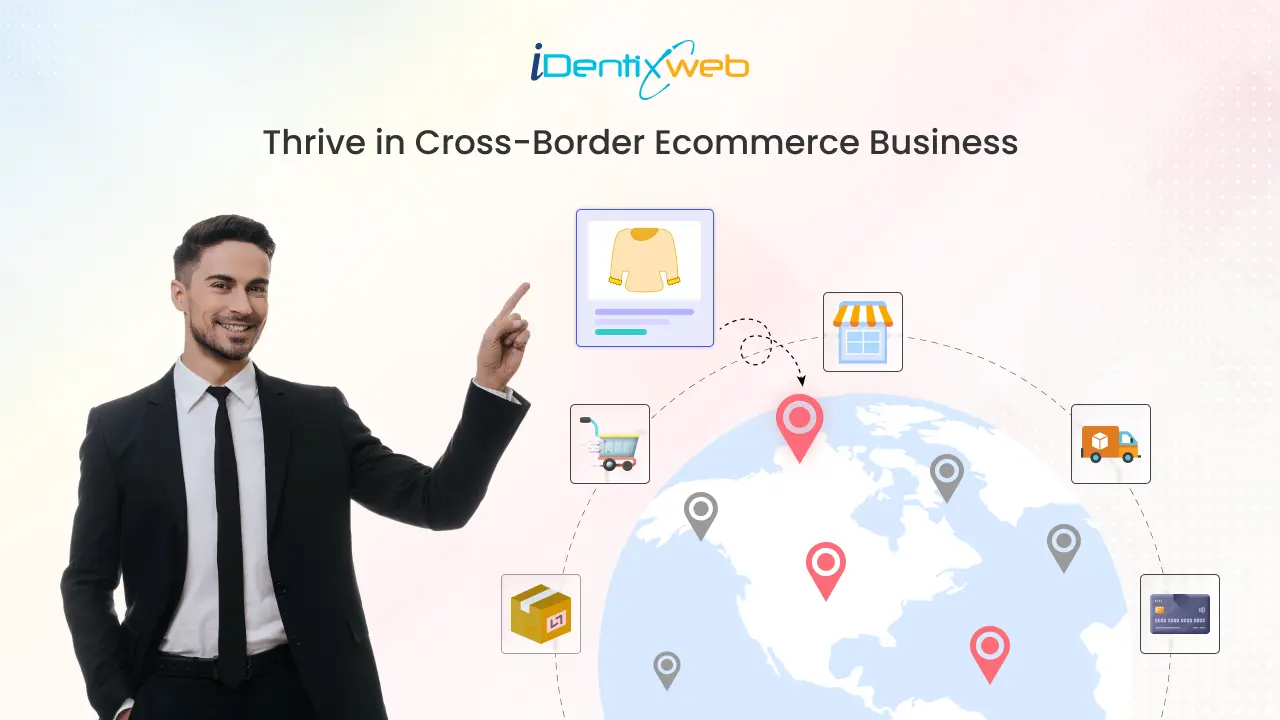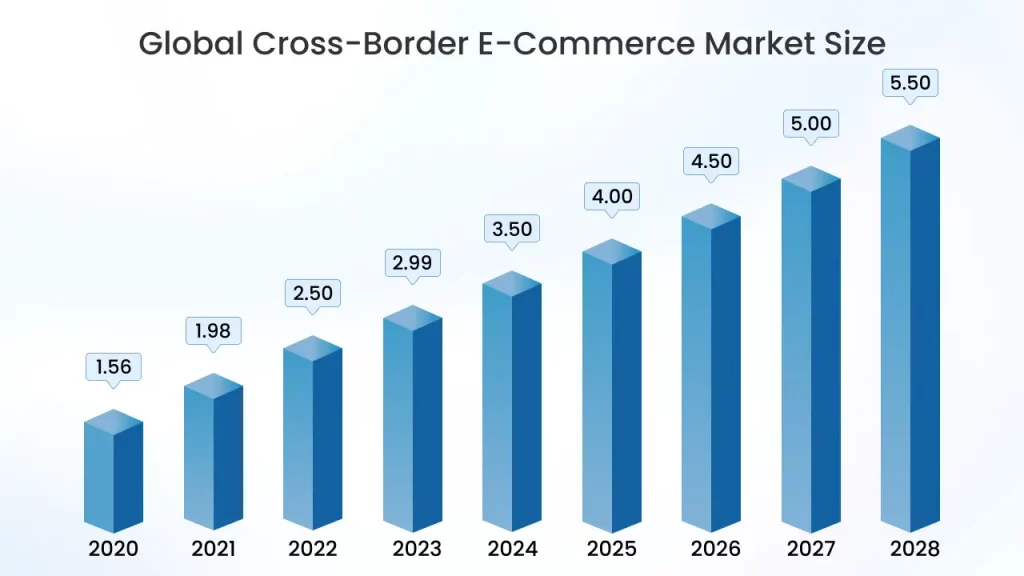
With the rise of cross border ecommerce, businesses have vast opportunities to grow both globally and domestically. The global market is projected to hit a staggering $16.4 trillion by 2032, opening up multiple avenues for merchants to generate revenue worldwide.
The market for cross border ecommerce is expanding rapidly. See the infographic below to understand its growth.

Numerous businesses recognize that expanding sales to international markets might seem daunting, but cross-border ecommerce has the potential to transform a local business into a global brand. Whether you're a small business or a globally recognized name, entering international markets can significantly scale your sales and increase your customer base.
This guide will help you understand why cross border ecommerce is essential for scaling your business and provide valuable insights for success in the global market.
What is Cross Border Ecommerce?
Cross border ecommerce refers to the buying and selling of goods and services between businesses and customers located in different countries via online platforms.
Now, we’ll look at the benefits and challenges of cross border ecommerce, helping you grow your business globally and tap into new markets.
Top Key Benefits of Cross Border Ecommerce

Broader Customer Reach
One of the main advantages of cross border ecommerce is the ability to connect with customers across the globe. Expanding your reach internationally opens doors to new markets, bringing in customers who were previously unreachable. This can lead to a significant increase in sales and revenue.
Stability Through Revenue Diversification
Selling in multiple international markets helps businesses reduce reliance on any single market. If one market faces an economic downturn or saturation, global sales from other regions can help stabilize revenue. This diversification strengthens the business, ensuring steady cash flow and reduced vulnerability to local economic shifts.
Gaining a Competitive Edge
Entering international markets offers a distinct competitive advantage. By selling abroad, businesses differentiate themselves from competitors that only operate locally. International expansion can also attract customers seeking products unavailable in their local markets. Additionally, building a strong global brand presence can enhance customer loyalty, positioning the business for long-term growth.
Expanding Supplier and Partnership Networks
Cross border ecommerce also unlocks opportunities to collaborate with new suppliers and partners. By broadening your network, you can source high-quality materials at competitive prices or even find new innovative products to offer. Working with international suppliers can improve product quality and streamline your supply chain, boosting overall profitability.
Enhanced Customer Satisfaction
Selling internationally allows businesses to cater to the diverse needs and preferences of customers around the world. By offering localized shopping experiences, such as providing payment options specific to each country, translating product descriptions, or offering region-specific shipping options, you can significantly improve customer satisfaction and build loyalty across borders.
Increased Brand Recognition
Cross border ecommerce boosts brand visibility, helping businesses become known globally. As more people become familiar with your brand in various countries, it enhances recognition, builds trust, and promotes long-term customer relationships. Using an AI ad generator can help you reach even more people, making it easier to attract new customers and build lasting loyalty.
Opportunities for Innovation and Growth
By selling internationally, businesses can innovate and experiment with different product offerings, marketing strategies, and pricing models based on regional preferences. This exposure to diverse markets helps you stay ahead of trends and better adapt to consumer demands, fueling continued growth and innovation.
Access to New Revenue Streams
By entering international markets, businesses unlock additional revenue streams. This can help offset reliance on the domestic market, especially during off-seasons or periods of market slowdown. These new revenue sources contribute to a more balanced and sustainable business model, aiding long-term financial growth.
Challenges of Cross Border Ecommerce
Logistics and Shipping
International shipping is undoubtedly one of the biggest challenges for cross-border merchants. With shipping costs, delivery times, and customs duties to consider, this is a complex and potentially costly process for international retailers.
Customs and Regulatory Compliance
Many countries have different rules and regulations regarding tariffs, taxes, and customs. Furthermore, compliance with local laws can be complex when selling internationally, and failure to comply with local laws can result in fines and delays.
Payment Processing
Cross border payment transactions often involve multiple currencies; therefore, there are extra steps and more security to address when processing a payment. Merchants have to find payment systems that can securely and efficiently process international payments.
Cultural and Language Barriers
Selling to different cultures means adjusting marketing, website content, and product offerings for culturally preferred targeting. Misreading cultural expectations can lead to customer dissatisfaction or damage to your brand.
Customer Support
Providing excellent customer support at a distance is to be expected in many aspects, but when you add multiple languages and time zones into the mix, it gets tricky. Each international customer also has their own set of expected response times when dealing with communication, refunds, and returns.
Once we understand what cross border ecommerce is, along with its benefits and challenges, the next step is to implement strategies to achieve success in this global market.
Steps to Achieve Success in Cross Border Ecommerce
#1. Finding the Right Markets
By conducting research to determine markets where your products are in demand you can choose one market to target first, learn about the market and grow that presence before scaling into additional countries.
#2. Check For Product Prohibitions
Conduct thorough research to determine the import regulations of the markets you are considering targeting. Some products are inherently restricted from being imported, such as food items, cosmetics and some electronics.
#3. Determining Prices and Taxes
As you set your prices, consider the full burden of the costs you are estimating based on the inbound shipping, customs duties and local taxes. Research your competitors pricing in your target market and ensure the products you sell are priced competitively while ensuring you can still make a profit.
#4. Leveraging Third-Party Logistics
Responding to options, would encourage you to use reputable third-party logistics partners, such as ShipBob, DHL, and FedEx, who have the international experience to offer documentation and shipping of packages. They will be able to efficiently manage warehousing, order fulfilment, and returns, allowing you to focus on growing your business.
#5. Outsourcing Customer Support
Engage local customer support service providers as they understand the language, culture and expectations of the customer in your defined target market. Local resources can ensure communication blocks are minimized and increase customer satisfaction.
#6. User Testing
Make sure to user test your site in the markets you will be launching in to find changes you will need to make (in design, content, or functionality) to upgrade the experience for your international customers.
#7. Conducting Market Research
Research is needed to help you determine which international markets are best positioned to sell your products. Look at the demographics of your customers and purchasing power, as well as information about domestic or local competitors.
#8. Localization
To expand and be successful globally, you will need to localize your ecommerce store. Make sure to translate your website into local languages, offer currency conversions, and set local prices based on economic conditions.
#9. Packaging International Shipping
Partner with global shipping carriers in advance to help with shipping processes and options. Offer various delivery options and take into consideration free or flat rate shipping to optimize the experience (and/or purchase) for your international customers.
#10. Global Payment Options
If you are including international markets on your ecommerce platform, use payment gateways that support international transactions and allow the use of different currencies. Customers will only make purchases if payment options are secured and user-friendly in global ecommerce, therefore build trust with potential customers.
Top Cross Border Ecommerce Platforms
Choosing the right platform is crucial for scaling your business internationally. Here are some top platforms to consider:
1. Shopify: A leading ecommerce platform with multi-currency support, localized marketing, and global selling capabilities.
2. BigCommerce: Offers built-in global payment integrations and international shipping tools for seamless cross-border selling.
3. WooCommerce: A WordPress plugin that supports international selling with customizable shipping methods, currency converters, and other global tools.
Conclusion: Ready to Take Your Business Global?
Cross border ecommerce has become a need for businesses looking to expand globally and grow their market share, rather than a luxury. Through the knowledge of the advantages, knowledge of the hurdles and the implementation of appropriate methods, merchants will be able to realize the tremendous opportunities that exist in global markets.
Start scaling your business globally and tap into the potential of ecommerce cross border today.
FAQs
1. How do I get started with selling internationally?
To get started selling internationally you should choose the right platform, research various markets and localize your website for the international shoppers.
2. Why should my business consider cross border ecommerce?
It opens up new revenue channels, grows your customer base and provides diversification and mitigated risk from global markets.
3. Can I sell to all countries through cross border e commerce?
Not every country is a great choice for cross-border sales; therefore, market research can help with finding suitable markets that have the proper infrastructure, technology and regulations.
4. How do I handle inventory for cross border ecommerce?
You should use a centralized inventory system or inventory management system that syncs inventory levels across multiple locations to avoid a surplus/deficit in stock.
5. What is an example of cross border ecommerce?
Sellers on Amazon or eBay who can ship internationally to customers in over 200 countries are an example of cross-border ecommerce.




![How to Create Shopify Bundles With & Without an App [2025] How to Create Shopify Bundles With & Without an App [2025]](https://www.identixweb.com/wp-content/uploads/2025/11/10-11-Mon-Blog-How-to-Create-Shopify-Bundles_-With-Without-a-Shopify-App.webp)
![Black Friday Statistics: The Only Stats Merchants Need [2025] Black Friday Statistics: The Only Stats Merchants Need [2025]](https://www.identixweb.com/wp-content/uploads/2025/11/10-11-Mon-Blog-Top-Black-Friday-Stats-Every-Online-Merchant-Should-Know.webp)

About the author
Bhavesha Ghatode
Explore Content with Bhavesha, a passionate and dedicated technical content writer with a keen understanding of e-commerce trends. She is committed to sharing valuable insights, practical assets, and the latest trends that can help businesses thrive in a competitive environment.